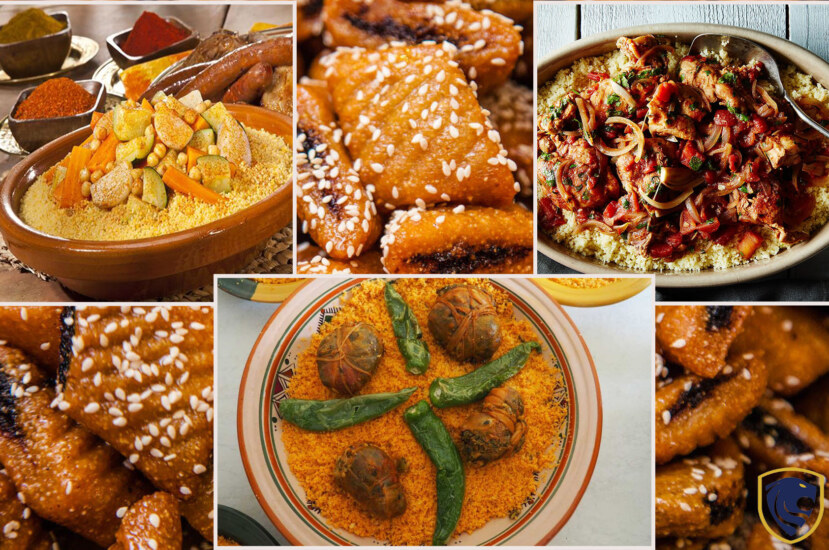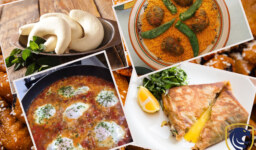Tunisian cuisine is a rich tapestry of flavors, aromas, and traditions that have been passed down through generations. It is a harmonious blend of Mediterranean, Arab, Berber, and French influences, creating a unique and diverse culinary experience. The heart of Tunisian cuisine lies in its use of fresh, locally sourced ingredients, combined with an array of aromatic spices. Olive oil, a staple in Tunisian cooking, is used generously and imparts a distinctive taste to many dishes.
One of the most iconic dishes in Tunisian cuisine is couscous, a steamed semolina grain served with a variety of savory stews. These stews often feature lamb, beef, or poultry, simmered with vegetables like carrots, potatoes, and chickpeas. Harissa is a spicy chili paste made from red peppers, garlic, and spices. Also, it is a fundamental ingredient in many Tunisian recipes, adding a fiery kick to the dishes.
Couscous
Tunisian cuisine’s staple meal, couscous, is a delicious and adaptable food. Semolina wheat is used to make it, and it makes a delicate basis for a variety of toppings. A filling and substantial supper may be made by serving it with soft meats like lamb, chicken, or fish. Also, chickpeas, zucchini, and other vegetables are frequently added to dishes to improve flavor and texture. Couscous is beautiful because it may take on the flavor of the foods it is served with. The grains are steamed during the cooking process to produce light, fluffy, and properly cooked grains.

Couscous; Rich Tapestry of Traditional Tunisian Cuisine
Couscous isn’t simply a food. It’s a holiday in Tunisia. Families assemble to partake in this tasty meal, frequently on special occasions and during holidays. So, the air is infused with the scent of spices like cumin and coriander in Couscous.
The warmth and generosity of Tunisian culture are represented by couscous. It symbolizes the balance between grains and meats, which is the hallmark of North African cooking. Moreover, Couscous encapsulates the spirit of Tunisia’s culinary tradition, allowing both residents and visitors to savor its delectable simplicity and rich flavors, whether it is served in a busy souk or the comfortable setting of a family home.
Brik
Brik, a common street dish and appetizer in Tunisia is a crunchy treat that entices the palate. A delicious filling of egg, tuna, capers, and parsley is encased in this triangular pastry, resulting in a well-balanced mixture of tastes and textures. Every mouthful of the delicate, thin pastry, which has been perfectly deep-fried to a golden brown, is certain to have a delightful crunch.
Brik is unique because it can be eaten in a variety of ways, which makes it unique. Others enjoy it as a beginning at formal parties, while some prefer it as a portable snack. Also, it is popular among both residents and visitors because of the explosion of flavor created by the mix of runny egg yolk, salty tuna, and the tang of capers.

Brik
The origins of Brik are firmly ingrained in Tunisian culture and showcase the inventiveness of its cuisine. It represents the rich culinary legacy of Tunisia and is more than simply a simple meal. Moreover, Brik-making is an art that demands finesse to precisely wrap the contents before frying. As a result, a crispy, aromatic package is created that perfectly captures Tunisian street cuisine.
Brik is a must-try whether you’re strolling through Tunisia’s crowded marketplaces or relaxing in a café. The combination of its crispiness and the filling’s savory flavor creates a dish that lingers in the mouth and leaves a lasting image of the nation’s colorful culinary tradition.
Harira
The thick soup known as harira, which is popular in Tunisia, is a culinary marvel bursting with flavor. The rich combination of tomatoes, lentils, chickpeas, and lamb in this classic recipe makes for a filling and healthy lunch. Cumin, coriander, and turmeric are among the fragrant spices that give the soup its warm, soothing flavor. Harira is unique since it may be served at a variety of events and is especially popular during Ramadan to break the fast. A pleasant and substantial dish is produced by combining delicate lamb, earthy lentils, and the robust richness of chickpeas. Harira is more than simply food. It’s a cultural practice that serves as a sign of joy and community.

Harira; Rich Tapestry of Traditional Tunisian Cuisine
Harira preparation is an art, and every family frequently has a special recipe that has been handed down through the decades. The correct simmering of the soup allows the flavors to merge in a delectable symphony. Dates and figs are frequently added to harira to enhance its sweetness and texture and counterbalance the soup’s savory undertones.
A bowl of harira tastes like the essence of Tunisia: a fusion of culture, tradition, and culinary prowess. Also, it is a standard in Tunisian cooking and represents the nation’s rich culinary tradition because of its robust warmth and aromatic spices. Harira allows everyone to indulge in its natural deliciousness and savor the essence of Tunisian flavors, whether it is eaten in a crowded souk or at a warm family supper.
Lablabi
A tasty and filling chickpea soup known as lablabi, a famous Tunisian comfort meal, warms the body and the spirit. The foundation of this meal is made up of boiling chickpeas that have been seasoned with garlic, cumin, and olive oil. It’s a straightforward yet filling dish that’s frequently eaten for breakfast, especially in the winter.
The blend of intense flavors and textures in Lablabi is what sets it apart from other foods. The chickpeas give the soup a creamy texture, while the cumin and garlic give it a delicious flavor. To add layers of flavor and richness, lablabi is frequently garnished with items like olives, capers, tuna, and even an egg cooked in oil.

Lablabi
Lablabi is a cultural experience as well as cuisine. Each bowl has a unique touch since families frequently pass down their family’s secret recipes over the years. The dish is an essential component of Tunisian culinary tradition and represents the nation’s inventive use of basic materials.
The versatility of Lablabi is what makes it so attractive. You may find it at busy markets, street booths, and even neighborhood houses. Lablabi perfectly encapsulates the spirit of Tunisian warmth and friendliness, whether it is served in a straightforward bowl or with lavish garnishing. Inviting everyone to savor the genuine flavors of Tunisian cuisine, its simplicity and heartiness make it a favorite among locals and tourists alike.
Tagine
The beloved Tunisian meal tagine is a savory stew that perfectly captures the essence of North African flavors. This culinary wonder of slow cooking blends luscious morsels of meat—typically lamb or chicken—with a variety of veggies and spices. A symphony of flavors is produced in the dish by the use of cumin, coriander, and turmeric. The cooking style of a tagine is what distinguishes it. The components are traditionally cooked slowly in the same name-brand unique ceramic pot, allowing them to combine flawlessly. As a consequence, the spices are absorbed into the veggies and delicate meat, resulting in a flavorful and satisfying combination.

Tagine; Rich Tapestry of Traditional Tunisian Cuisine
A celebration of Tunisian hospitality, tagine. There is a wide range of tagine recipes. While some versions emphasize the spiciness with spices like harissa, others emphasize the sweetness with the addition of apricots and almonds. Whatever the variation, Tagine is a favorite in Tunisian homes because it exemplifies the skill of flavor balance. An experience, enjoying a bowl of tagine is more than simply a meal. Each mouthful is an invitation to the heart of Tunisian culinary legacy, a voyage through the fragrant lanes of the country’s spice markets, and a taste of tradition.



